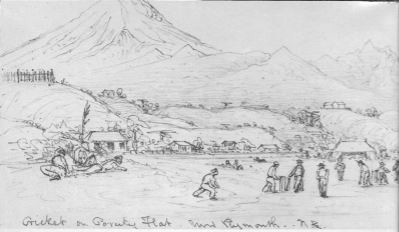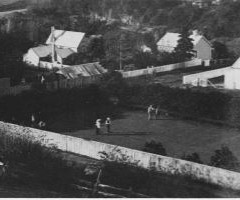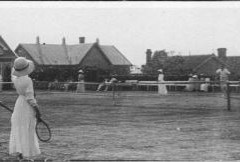11:3
It was this trial which roused the townspeople to strongest criticism of prison conditions. The offence had been committed 12 months before the trial, during which time the two men had been kept in the little stone jail in leg irons and on a meagre diet. One correspondent told readers of the Taranaki Herald that as it was impossible to ensure the safe confinement of the men they had been removed to Auckland 'at the cost of this province, which in addition loses the benefits of the prisoners' labour for 15 years.' The editor agreed with this and most of the many other letters on the subject, proclaiming in 1864 that the prison was 'a disgrace to the province.' The colonial Surgeon, Dr Peter Wilson, inspected it, as did a select committee from the Provincial Council. Both reported that it was unfit for human habitation. The Prison Defaulters' Record Book illustrates the comparative harshness of prison life. In 1865 William White, Samuel Charles and James Broderick, all on remand, broke out of the jail by lifting the floor and digging a passage to freedom. Recaptured next day, they were placed in irons and handcuffs 'until the next sitting of the Supreme Court.' Solitary confinement in irons and on a diet of bread and water for up to one month was the punishment for such 'crimes' as insolence, refusing to work and 'misbehaving at prayers.' On January 12, 1867, the Herald reported an inquest on John Greer, the fourth person to die while in the James Lane jail. A letter to the editor in the same issue castigated the regulations of the magistrate, Josiah Flight, and the care of the colonial surgeon, Dr Wilson, and urged that 'immediate steps be taken to replace them with men of more humanity, less red tape and disregard for human life.' Protests such as these had results. The old military hospital on the flat land between Marsland Hill and the Huatoki River was taken over on November 2, 1870, and was proclaimed a public jail by Governor Bowen on December 22. This two-storeyed pits awn timber building was 'reinforced by iron over the windows, the lower half being used as a prison and the upper storey set aside for accommodation of William J. Bosworth and his family. ' 15 Bosworth, the jailor, was a stern disciplinarian, but according to the prison records he showed great tact in the management of those placed under his charge. In 1874 it was proposed that New Plymouth be made the depot for long-sentence prisoners from all over New Zealand, and that prison labour might be used to build tile harbour. Central government set aside $20,000 for building such a prison at Ngamotu. A site was procured and tenders were called for a 200-inmate institution. Stormy meetings in New Plymouth and Wellington resulted in the scheme being abandoned and most citizens of the town breathed sighs of relief. Prison labour was used to build the present stone jail, which was occupied in 1880. A memorial to Bosworth's tenure between 1869 to 1873 is a stone above the archway into the exercise yard, inscribed: 'New Plymouth Gaol 1879. J. Bosworth, Gaoler.' Prisoners were used in the construction of the breakwater at Ngamotu.
For six days a week they were unlocked at 6.15 a.m. each day and marched to their work under armed guard. They were not permitted to communicate with the public. In fact, one member of the public who did communicate with a prisoner found himself joining them for a month 15. During inclement weather and between tides the prisoners were marched to a cave in Mikotahi Rock, which had an iron grille for a face and which became known as 'Convicts' Cave.' Work ended at 6 p.m. and the men were locked up for the night at 7. On the night after convicts had worked for the last time on the breakwater, November 13, 1889, William Fisher began singing and whistling in his cell and calling out to female prisoners in the adjoining corridor. He paid the price for his exuberance-three days of solitary confinement on bread and water. The new prison housed a variety of offenders of both sexes and of all ages, as had the James Lane jail-prisoners on remand, debtors and short-term convicts. An entry in the defaulters' book signed by E. Rickerby ,jailer, on July 7, 1889, reads: 'In compliance with the sentence passed at the Supreme Court at New Plymouth on the 23rd June 1887, Prisoner James Rielly was privately whipped with fifteen strokes of the "cat" at 7 a.m. on the 7th July, 1887 in the presence of the chief gaoler and gaol surgeon. The surgeon gave instructions that the strokes were to be given light as the prisoner was young and had a bad back.' Rielly had been sentenced to two years' hard labour and to be whipped with 15 strokes once a month for three months. His offence was molesting a female in Vivian Street near St Mary's Church. There is no record of subsequent whippings. Corporal punishment was abolished in 1941. . When the prison was built it was outside the residential area and well hidden from the town by Marsland Hill. As expansion proceeded and the land around it was built on, residents complained against such an institution in their neighbourhood, with its unsavoury connotations, and utilising valuable housing land. Many moves in later years were made to have it relocated outside the city. In 1952 the Minister of Prisons indicated that while the Government was sympathetic, such a project must take second place to hospital, housing and school needs. Suggestions were made that the stone building should be used as an art gallery or a Maori wars museum, but it is still a prison and there is little indication of it being anything else. Over the years it has been used to house murderers, rapists and other long-term prisoners. Up until 1950 most of New Zealand's sexual offenders served their sentences at New Plymouth. It is now classed as a medium security institution. In 1980 a staff of 30 under Superintendent William Elliott were responsible for supervising between 50 and 65 male prisoners serving sentences varying from a few months up to 12 years.
There have been few prisons in the world which are absolutely escape-proof. The massive granite-block jail at New Plymouth is no exception, and over the years there have been several manhunts for escapers. Two of the most dramatic surrounded the cases of 'The Highwayman' and George Wilder. Robert Wallath was 19 when in 1892 he approached William Collins, an elderly cripple, keeper of the Omata tollgate, presented a revolver and stole $10. Three months later he held up three men in Devon Street. Wearing a military tunic, a helmet and with his face covered by 'what appeared to be a grey beard,' he stole from them 'threepence and a watch.' Then, disguised as an 'elderly gentleman' carrying a long sword 'which frequently clanked,' he entered the White Hart Hotel, held up the drinkers and made off with 'about fifteen shillings and a bottle or whiskey.' Using a borrowed horse which bolted when his flapping sword scared it, he fell off and his pistol discharged harmlessly. But Wallath escaped. He committed several other holdups, always disposing of his disguises and returning to the scene to mingle with the crowds which invariably assembled to discuss the exploits of'the highwayman,' which had been well reported in the national Press. The Police Commissioner in Wellington, Arthur Hume, came under public and political pressure to ensure a quick arrest for so brazen and recurring a crime, and wired Inspector J. B. Thomson, of New Plymouth, offering the services of a detective, because: 'Minister is anxious to know whether you have yet got any clues to detection of Highwayman.'18 Wallath's undoing came when he attempted to hold up Mary Cottier who was behind the bar of the Criterion Hotel. He was jumped upon by two occupants of the bar and during the struggle his pistol went off, wounding one of the men, Harold Thomson (Inspector Thomson's son). He was remanded in custody. Two months before his Supreme Court trial Wallath escaped from the prison. His freedom was short-lived, for he was captured as he climbed a clay bank out of the Huatoki Stream, and put in irons. At his trial it was explained that Wallath had suffered from brain fever at one time and also from epileptic fits, and that the main motive for his exploits seemed to be a morbid desire for notoriety, which he certainly achieved. Following his arrest Inspector Thomson was rapped over the knuck- les by Commissioner Hume for not sending a full and prompt report. 1 9 Wallath was sentenced by Mr Justice E. T. Conolly to eight years' imprisonment, but was released after four and a half years following submissions made by residents of New Plymouth protesting against the severity of his sentence. Wallath was a carpenter by trade, as was his father, who lived in what is now Wallath Road in a double-gabled house which is still standing.
He returned to New Plymouth where he married and was the father of four children. He became a highly respected member of the community, a voluntary social worker, and often did carpentry work for people in need at no cost. When he died in 1960, 'few people connected the philanthropic old gentleman with the young boy who had made daring holdups in the late 1800s.'20 Wilder, an escaper of later times, created an even greater sensation in New Plymouth and much farther afield. On May 17, 1962, when he was serving a term of imprisonment for convictions of burglary, shopbreaking and theft, he scaled the high wall of New Plymouth Prison and escaped. He was not seen again until July 10, when he was recognised at Ongarue, near Taumarunui. From then until his capture on July 21, near Whakamaru, Wilder's amazing evasion of large parties of police caught the public imagination and lent a certain romance to his exploits. At the time of his capture he had been at large for 65 days. In January, 1963, he escaped with three others from Mount Eden Prison in Auckland and again the manhunts captured widespread public attention. He was sighted several times, and when he was recaptured about 35 kilometres east of Taupo he had been free for 172 days, having travelled 2500km and committed 40 crimes. In 1964 he escaped once more from Mount Eden and was recaptured after three hours. In 1965 he was again a centre of attention when he took part in the Mount Eden riots.
From almost the beginning of settlement the legal profession has had great influence on the affairs of New Plymouth, much of it shrouded by professional reticence. For the first two decades the town's lawyers were men who had qualified in Great Britain and Ireland, no doubt encouraged to emigrate by the New Zealand Company as persons of financial and intellectual standing, and throughout the area's history they have become associated in a wide range of activity outside their profession. One of the earliest problems facing the settlers was not so much court (criminal and civil) business, but that involving local government, administration and land purchases. Among early names associated with the law in the town was that of the Halse brothers, William and Henry. They arrived in the Amelia Thomson in 1841. William became the resident agent for the company, a Justice of the Peace, and Acting Commissioner of Crown Lands. Henry was Commissioner of Native Reserves and later a judge of the Native Land Court. In the first statistical returns for Taranaki dated June 1, 1843, under the heading 'Trades and Professions,' were two medical practitioners, and 'three lawyers of all grades' . W. H. Skinner records that Thomas Standish, solicitor, came to New Plymouth in that year where he found 'all the paraphernalia for litigation fully established . . . but it was evident that business was decidedly slack during those pioneering days.' He was appointed the first official clerk to the magistrate, Captain King, on August 5 and officiated at the police station at Mount Eliot from that date. His son, Arthur Standish, studied law in Auckland and in 1861 opened a practice in New Plymouth as a solicitor. Two years later he became Crown Prosecutor, and in 1876 was elected the first Mayor of New Plymouth and was also a member of the first New Plymouth Harbour Board.


